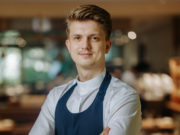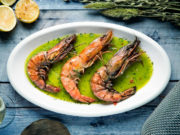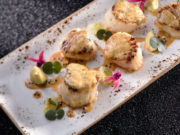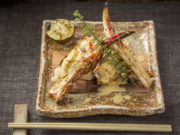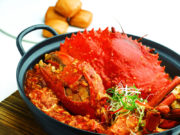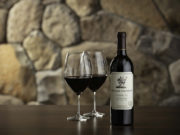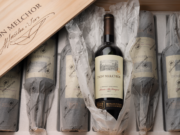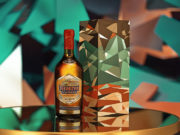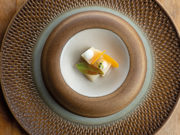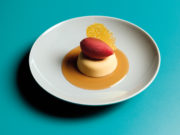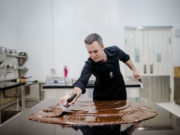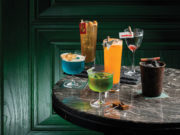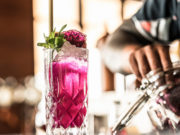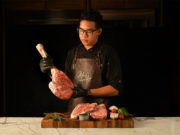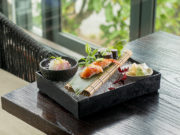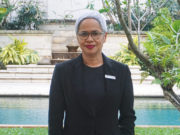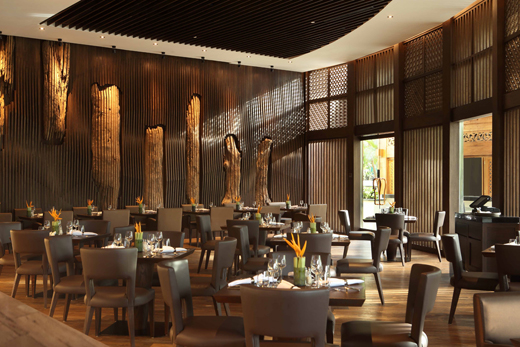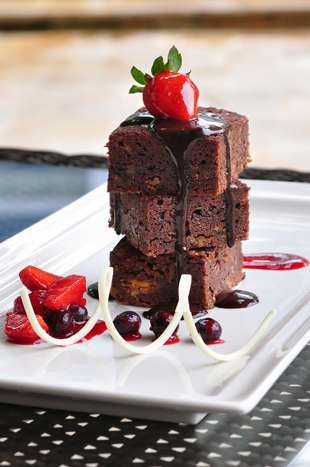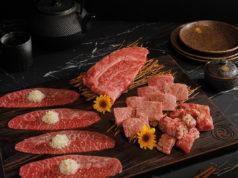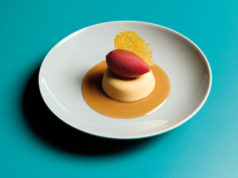A Feast for the Senses
The newly opened Rasa restaurant at the InterContinental Jakarta MidPlaza offers an innovative take on the buffet restaurant, with loads of freshly prepared dishes and delicacies to dazzle your eyes and tastebuds.
Good food is about more than just taste. Seeing fresh ingredients and experiencing the sights, smells and stories that go with them builds anticipation and makes for a truly satisfying meal.
That is the concept behind Rasa, the recently opened restaurant at the InterContinental Jakarta MidPlaza that has replaced the former Java as the hotel’s all-day dining venue.
“Rasa” is the Indonesian word for “taste,” but is also used to describe feeling and sensation. Rasa restaurant builds on this idea to create a dining experience that aims to incorporate all of the senses.
The remodeled space is decorated in hues of brown and black, with jagged panels of sungkai wood inlaid in the walls to give texture. Accents of Javanese heritage are seen in decorative wood carvings on pillars and window latticework based on batik motifs.
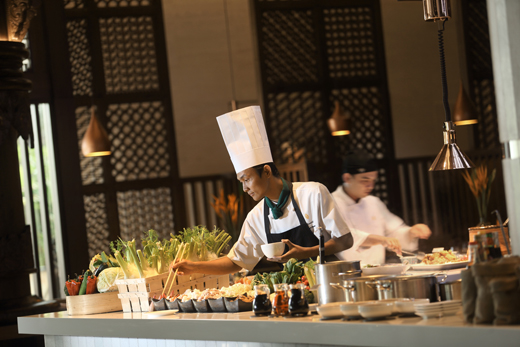
The subdued surroundings make way for the focal point of the dining area – a white marble buffet island and open kitchen with giant crustacean-like light sculptures dangling overhead.
That island is stocked with a cornucopia of fresh seafood, meat, fruit, vegetables and other raw ingredients that are refreshed continuously throughout the day. During a lunchtime visit, one chef is seen boiling noodles in the open for soup; another expertly slices salmon for sashimi.
There’s clearly a lot to take in, so I start the meal with a plain bowl of pumpkin soup. There’s also a tom yam available with a wide array of optional garnishes, as well as the noodle soup kitchen with mix-and-match bean sprouts, tofu, meat and fat rice noodles. With a warm belly, I’m ready to approach the raw buffet.
Executive chef Gary Palm emerges from the side kitchen to explain his unusual buffet layout that shuns the use of the bain-marie, the heaters usually used to keep buffet items warm.
Cooking up all the food before the guests arrive makes things easier on the kitchen staff, he says, but it doesn’t do the guests any favours.
Food tastes best cooked fresh, and that’s what Chef Gary tries to achieve with the open kitchen layout. His team is busy all day preparing fresh dishes on request.
Gary also makes an effort to source local ingredients, cutting the time as much as possible from farm to table. His heirloom tomatoes come from Pluit, West Java, while the seafood is flown in from Bali. Freshwater crawfish are sourced from a sustainable farming project called TuckerBox, with branches in Sumatra and Bekasi.Chef Gary raves about the quality of the home-grown craw. “They’re like potato chips,” he says. “You eat one and you’ll want to have ten.”
Cooked fresh without any seasoning, the crawfish are served whole to be uncurled, peeled and enjoyed.
The meat inside is tender and sweet, and tastes of pure water. Followed by some Bali crab and shrimp,
the contrast of freshwater to saltwater is clear. The meat is just as succulent, but carries the tang of the sea.
Next door to the shellfish, sashimi is under the knife with rows of bright salmon, pink tuna and creamy squid filling up a glass display cabinet. Soy sauce, chilli and wasabi can be mixed to taste before picking choice slices of sashimi from the cabinet.
Across from the island, another team of chefs is busy preparing International, Chinese and Indian dishes at a side station (which also houses a carving station). Their kitchen is equipped with a Tandoori oven used to make iconic Indian curries as well as handmade flat breads to be served hot. The curries are full and flavoursome without being overly spicy. Pinches of oily flat bread make it easy to polish off a plateful.
Also at the side station, glazed Peking ducks hang like fruit in the window, drawing diners in. Chef Gary has found his own use for the Chinese delicacy – his signature Rasa duck tacos.
I start picturing a cross between Mexican soft tacos and Chinese duck pancakes, and am surprised to see
the waiter bring out Tex Mex hard-shell tacos with grated cheese spilling onto the plate. Cheese and hoisin sauce is unusual, but with guacamole and duck it turns out to be a surprisingly good combination.
What started as a light lunch is quickly turning into a midday feast and I haven’t even touched any of the salads or cold cuts. The dessert station – as impressive as it is with its freshly cooked waffles, pancakes and chocolate fountain with local strawberries – is looking increasingly out of reach.
Chef Gary recommends going straight for the triple chocolate brownie, another of his specialties. The dense dessert is made up of three warm brownies topped with fudgy ganache, stacked up against a thin slice of dark chocolate.
The food at Rasa focuses on the basics – high-quality ingredients cooked in a way that lets the natural flavours shine. In an open kitchen, there is no chance for behind-the-scenes trickery and so the result is honest food served straight.
The flexibility in this approach comes in combining flavours in new ways, as in Chef Gary’s duck tacos, or in guests creating their own combinations from the ingredients on display. Most commendably, the use of locally sourced ingredients shows that food doesn’t have to be imported to be sensational
(www.jakarta.intercontinental.com/resto/rasa)


